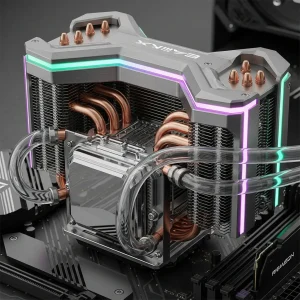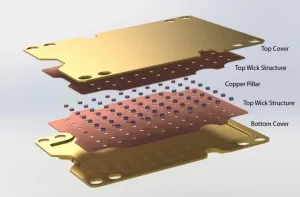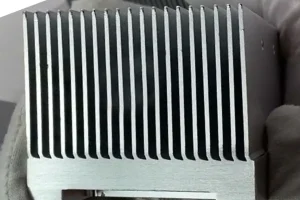Heat Sink What It Is and How It Works
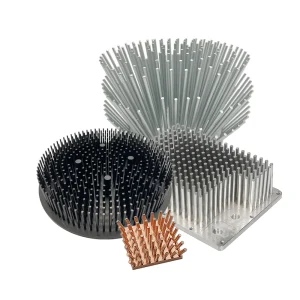
You rely on a heat sink to keep your computer’s CPU and other electronics safe from overheating. The heat sink sits on top of the chip and absorbs heat, spreading it out through metal fins. This design lets heat move away quickly and keeps your device running smoothly. When you use a custom heat sink, a heat pipe heat sink, a Liquid Cold Plate, or even a Vapor Chamber Heatsink, you help your system avoid damage and last longer.
Cooling solutions like heat sinks extend the life of CPUs and electronics by reducing thermal stress.
- CPUs rarely fail early unless they overheat.
- Proper cooling prevents damage and keeps your system reliable.
Key Takeaways
- A heat sink helps keep computers and electronics cool. It moves heat away from chips. This stops damage and helps things work better.
- Heat sinks take heat from the chip to metal fins. The fins let the heat go into air or liquid. This happens through convection.
- Picking the right heat sink depends on how much heat your device makes. You also need to think about space and cooling needs. Decide if you want quiet or strong cooling.
- Using thermal paste and putting the heat sink on right helps move heat better. This keeps your device working well.
- Clean your heat sink often and check the airflow. This helps it work better and makes your electronics last longer.
What Is a Heat Sink?

Definition
You see a heat sink as a special device that helps keep electronics cool. It looks like a block of metal with many thin fins or ridges. You usually find it sitting on top of a computer’s CPU or other important chips. The heat sink pulls heat away from the chip and spreads it out over its surface. The fins give the heat more space to escape into the air. You notice that most heat sinks use metals like aluminum or copper because these materials move heat quickly.
Tip: If you touch a heat sink after your computer runs for a while, you feel warmth. This shows that the heat sink is working to remove heat from the chip.
Purpose
You rely on a heat sink to protect your electronics from getting too hot. When your CPU works hard, it creates a lot of heat. If you do not control this heat, your computer can slow down or even stop working. The heat sink keeps the temperature safe by moving heat away from the chip. This helps your computer run smoothly and last longer.
Here are some reasons you need a heat sink:
- It prevents overheating and damage.
- It helps your computer perform better.
- It extends the life of your electronics.
- It keeps your system stable during heavy use.
| Benefit | What It Means for You |
|---|---|
| Prevents damage | Your CPU stays safe |
| Boosts performance | Your computer runs faster |
| Increases lifespan | You use your device longer |
You see that every computer and many other devices need a heat sink. Without it, your electronics would not work as well or last as long.
How Heat Sinks Work
Heat Transfer Steps
You can understand how a heat sink works by looking at the steps of heat transfer. Each step helps move heat away from your computer’s CPU or other electronic parts. Here is how the process happens:
- The CPU or chip generates heat as it works.
- The heat moves from the chip into the heat sink. This step uses conduction, which depends on how well the heat sink material carries heat.
- The heat spreads through the heat sink’s fins and body. The heat travels from the hot side near the chip to the cooler edges.
- The heat leaves the heat sink and enters the air or a cooling liquid. This step uses convection and depends on the temperature difference and the size of the heat sink’s surface.
When you follow these steps, you help your device stay cool and safe.
Materials
You often see heat sinks made from copper or aluminum. Each material has its own strengths:
- Copper moves heat very well. It has a high thermal conductivity, which means it can carry heat quickly from the chip to the fins.
- Aluminum is lighter than copper. It costs less and resists rust. Many people choose aluminum for heat sinks because it works well and does not add much weight.
- Copper works best when you need to move a lot of heat fast. Aluminum is a good choice when you want a balance between heat movement, weight, and price.
- Aluminum’s thermal conductivity is lower than copper’s, but it still works for most cooling jobs.
You pick the material based on what your system needs most—speed, weight, or cost.
Surface Area
You improve a heat sink’s cooling power by increasing its surface area. When you add more fins or make the surface rougher, you give heat more places to escape. Studies show that rougher copper surfaces can boost the heat transfer rate by about 9%. Special fin shapes, like wave fins, also help move heat better than straight fins. If you use passive cooling, a larger surface area helps even more because it lets more heat leave through radiation. With active cooling, like fans, you need to balance surface area so air can still flow easily. In most cases, a bigger surface area means better cooling, but you must match the design to your cooling method.
Heat Sink Types
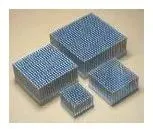
Passive
You use a passive heat sink when you want silent cooling. This type does not need any moving parts or electricity. The metal fins and base absorb heat from your CPU or chip. The heat travels through the fins and escapes into the air. You often see passive heat sinks in devices that do not get very hot, like small computers or routers. The large surface area helps the heat leave faster. You do not hear any noise because there are no fans.
Passive heat sinks work best in places with good airflow and low heat production.
Active
You choose an active heat sink for stronger cooling. This type uses a fan or blower to move air across the fins. The moving air helps carry heat away quickly. You find active heat sinks in most desktop computers and gaming systems. These designs include several important parts:
- Base: Touches the chip and spreads heat.
- Fins: Increase the area for heat to escape.
- Heat Pipes: Move heat from the base to the fins.
- Thermal Interface Material (TIM): Fills gaps for better heat transfer.
- Mounting Hardware: Holds the heat sink in place.
- Fan or Blower: Pushes air to cool the fins.
Active heat sinks keep your CPU cool even when you run heavy programs. You hear the fan working when your computer gets hot.
Hybrid
You pick a hybrid heat sink when you want a mix of quiet and strong cooling. Hybrid systems use a passive heat sink with a fan that turns on only when needed. This setup gives you better cooling than passive alone and uses less power than always-on fans. Hybrid heat sinks work well in places with moderate heat and normal room temperatures.
- You get better thermal performance than passive heat sinks.
- You save energy compared to fully active systems.
- You enjoy higher reliability because the fan runs less often.
Hybrid heat sinks offer a smart balance for many users. You get strong cooling without extra noise or power use.
Heat Sink Performance
Thermal Resistance
You measure how well a heat sink moves heat away by looking at its thermal resistance. This value tells you how many degrees Celsius the temperature rises for each watt of heat. You see this number written as °C/W. Lower numbers mean better cooling. For small heat sinks using only air, the thermal resistance can range from 2.4 to 3.8 °C/W. These work for low-power devices. If your device needs to handle more heat, you use a bigger heat sink or add a fan. PC CPU coolers often manage about 40 watts of heat. Always check the datasheet for the right value before you choose a heat sink.
Tip: Lower thermal resistance means your device stays cooler and works better.
Fin Design
You boost cooling by changing the shape and layout of the fins. Fin height, spacing, and shape all matter. Taller fins help move more heat, but you need the right space between them for air to flow. Special fin shapes, like curved or branched fins, can improve heat transfer and make the heat sink lighter. Split fins with slots help air move better and cool faster. Twisted or inclined fins mix the air and carry heat away more quickly. You get up to 24% better cooling with these designs. Always match the fin design to your airflow and space needs.
- Branched fins at the tips of main fins give you the most heat loss with less weight.
- Curved fins can improve cooling by about 12.5% and use less material.
- Split fins and special shapes help air move and cool your device faster.
Installation
You get the best performance when you install your heat sink the right way. Always use thermal paste or compound between the chip and the heat sink. This fills tiny gaps and lets heat move faster. Make sure the heat sink sits flat and tight on the chip. Good contact means better cooling. At Trenton, you find custom and standard cooling solutions. Our engineers test each system in tough conditions, even for military use. We use special fans and heat sinks to keep your devices safe and cool.
Note: Proper installation and the right thermal paste can make a big difference in cooling.
Choosing a Heat Sink
Requirements
When you choose a cooling solution, you need to look at several important factors. Start by checking how much heat your component produces. This tells you how much cooling you need. Next, decide if you want a passive or active system. Passive systems work well for quiet spaces and low heat. Active systems use fans and handle more heat.
You should also think about how well the cooling device moves heat. This depends on the material, thickness, and surface area. Copper and aluminum move heat quickly. The size and shape of the cooling device matter, too. Make sure it fits your space and meets your needs.
Here is a simple checklist to help you:
- Find out the heat output of your component.
- Pick passive or active cooling based on your needs.
- Check the material and design for good heat movement.
- Look at the airflow in your system.
- Make sure the size fits your space.
- Use thermal paste for better contact.
- Think about your budget.
Space and Compatibility
You must check the space inside your device before you pick a cooling solution. Measure the area around your CPU or chip. Some systems have tight spaces, so you need a compact design. Others allow for larger options with more fins or even fans.
Compatibility matters, too. Make sure the mounting hardware matches your device. Some cooling devices use clips, screws, or special brackets. Always check the manufacturer’s guide. If you have a custom system or special needs, you may want to talk to an expert.
| Type | Material | Best Use Case | Key Feature |
|---|---|---|---|
| Bonded | Copper, Aluminum | Large, high-power systems | High fin density |
| Skived | Copper, Aluminum | Small, high-airflow areas | Low thermal resistance |
| Extruded | Aluminum | General use | Cost-effective |
| Forged | Aluminum, Copper | Low-resistance needs | Strong, durable |
| Stamped | Sheet metal | Low-power devices | Adjustable fin shapes |
| CNC Machined | Aluminum | Custom or prototypes | Flexible design |
Best Practices
You get the best results when you follow a few simple steps. Always use thermal paste between the chip and the cooling device. This fills tiny gaps and helps move heat faster. Make sure the device sits flat and tight on the chip.
Check your airflow. Good airflow helps carry heat away. Clean dust from fans and fins often. If you work in a tough environment or need special cooling, ask an expert for advice. Custom solutions can help you meet strict needs.
Tip: Testing your system in real conditions helps you find the best cooling setup.
You play a key role in keeping your electronics safe and reliable. When you choose and install the right cooling solution, you help your devices last longer and work better.
- You prevent performance loss by keeping parts cool.
- You extend the life of your electronics by reducing stress.
- You avoid sudden failures and lower repair costs.
- You keep your devices running strong for years.
Regular cleaning and checks help your cooling system work its best. Good thermal management stops most heat-related failures and keeps your electronics dependable. If you want the best results, talk to an expert and match your solution to your system’s needs.
FAQ
What does a heat sink do?
A heat sink pulls heat away from your CPU or chip. It spreads the heat out so air can carry it away. This keeps your device cool and safe.
How do you know if your heat sink works?
You can touch the heat sink after your device runs for a while. If it feels warm, it moves heat away from the chip. You can also check your device’s temperature in the system settings.
Do you need thermal paste with a heat sink?
Yes! Thermal paste fills tiny gaps between the chip and the heat sink. This helps heat move faster and keeps your device cooler.
Can you clean a heat sink?
You should clean your heat sink regularly. Use a soft brush or compressed air to remove dust from the fins. Clean fins help air flow better and improve cooling.

